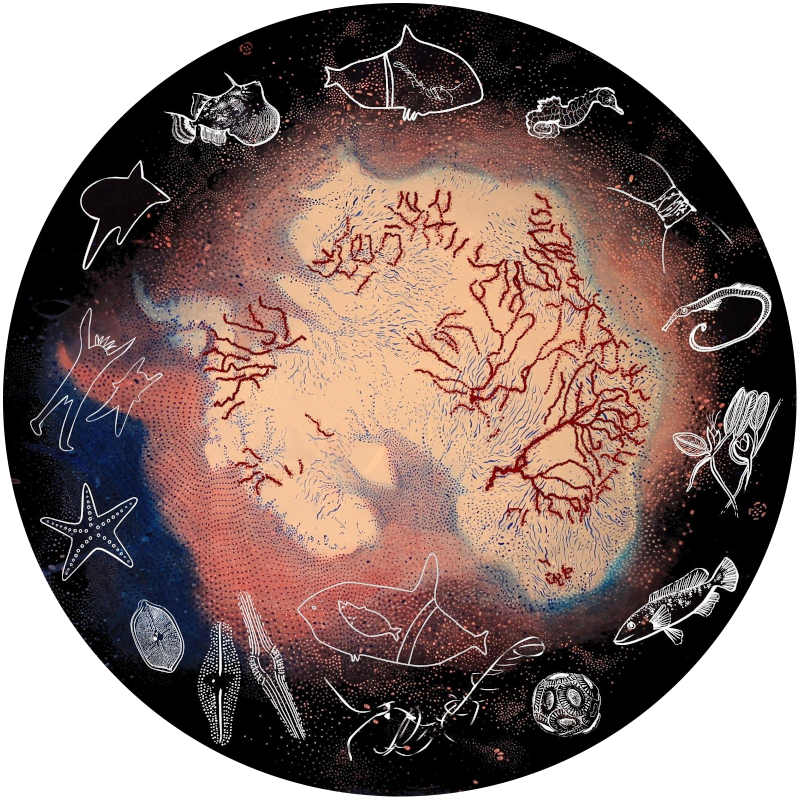Living Data
2016 Presentations
Oceanic Bliss Site Findings
Disclaimers, Copyrights and Citations
Presentations/Index 2010 2011 2012 2013 2014 2015 2016 2017 2018 2019 2020 2021 2022 2023 2024
William Gladstone and Lisa Roberts present
Eramboo Artist Environment, Ku-ring-gai
Saturday 7 May 2016
With excerpt from the symphony ex Oceano
Courtesy Lynchpin - the ocean project
The innovative Ku-ring-gai Ph art-science projectopens up creative opportunities for Living Data contributors, as ten scientists and ten artists, each with unique experience and training, collaborate in partnerships to expand understanding of Australia's iconic Ku-ring-gai National Park.
Scientist William Gladstone and I collaborate to create an installation, Oceanic Bliss, for the Manly Art Gallery and Museum, to share knowledge and experience of a seagrass meadow.
Transcript
William Gladstone (WG):
Just to position you in your thinking, Shona's space in right there next to us, so you would walk through Shona's and into ours, and there's a peep hole ... I think there's going to be a peep hole in the wall there ... where you can peep from Shona's into ours and vice versa. And we were just really enjoying hearing Shona's idea of having the floor - the wall painted up to about here, to represent the earth, and one of the ideas that Lisa and I have been playing around with, and maybe Lisa will tell you a bit further one, is having a projection coming down from the ceiling, which has a hemisphere suspended there, with a projector going onto it, to give you a sense of standing under water in a seagrass bed. So you're actually immersed in the seagrass bed, looking up through the canopy of the leaves. It's a very similar theme to what Shona's thinking, and we didn't even compare themes, as we were evolving our ideas here.
I'll just tell you a little bit before I hand over to Lisa, about what our subject is. Our subject is seagrass. As a marine biologist I've worked on seagrass for many years in Pittwater, right off where we were at Currawong, Mackerel Beach, Palm Beach, and also other places around the world. And the sort of science I do is the sort of biological understanding we need to conserve the marine biodiversity. That's what drives me and my science.
Seagrass is a very important ecosystem in Pittwater. It's biodiversity is very different to what you find in other parts of the sea bed that are unvegetated. It protects the shoreline. It sequesters carbondioxide from the water which enters from the atmosphere. And that sequestering ability is much greater than that of terrestrial vegetation.
So even though its area, totally around the globe, is much less than the terrestrial vegetation, the carbondioxide that it can sequester is about the same as terrestrial vegetation.
So scientifically it's incredibly interesting, and it's very important to us in the way we interest with the environment and the way we need to look after it.
I might just reflect on our collaboration. Lisa and I have worked on projects before. I've worked on some exhibition's she has organised before but this is the first time we have collaborated to produce a work of art. And it's been a big journey for moth of us. And I think at times our identity has swapped over, from who's the artist' who's the scientist - who's thinking in what ways. And to me that's a really good example of collaboration.
As a scientist I'm really interested in the creative process because it really underpins breakthroughs in science. It's a flash of creativity. It's not just mechanical or incremental growth of knowledge. It's those creative bursts that lead to breakthroughs in understanding. And I'm really interested in that whole creative process in the way we do that in science, and the way it's done in art as well. For me it's been a journey in understanding how Lisa thinks about the world, and I call her my great disrupter. Lisa will come with an idea I didn't think about before and suddenly I'm going off on that direction, which is really a great way to collaborate with someone. And it's not ... as scientists we're used to collaborating. We often work as groups of scientists together on a problem, because sometimes you just need a lot of brain power, or hands, to do some of the work we need to do. But it's the first time I've worked very closely with an artist. It's a very different sort of collaboration, and hugely rewarding and enjoyable.
Lisa Roberts (LR):
OK. Well I trained as an artist. I've been working with scientists since [2002] when I went to the Antarctic, which was an amazing life-changing experience. And the sort of conversations that I've observed, that scientists have with each other, are disruptive. A lot of very hard questions are asked at some of those meetings. 'Have you thought of this? Have you looked at it from this perspective?' And more and more you're getting scientists from different fields of science to come in and listen to each other, and ask questions that, as a marine biologist perhaps you wouldn't have thought of, with an astrophysicist, or a neuroscientist in your midst. So I think it's a logical progression to have more artists in your midst.
So, my training was in ... basically it started with dance, and I've always drawn, so animation was sort of a logical obsession that developed over my life.I was obsessed by Walt Disney, in those old films you might have seen, of him creating his first animations. He would have a real ... he would go to the zoo and look at real hippopotamuses, or they'd bring in a classical ballerina, and they'd draw from life. This is ages ago. They don't do that any more. (5:40/17:58)



















